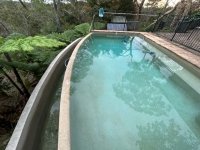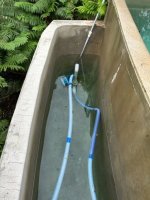- Feb 17, 2022
- 5
- Pool Size
- 50000
- Surface
- Plaster
- Chlorine
- Salt Water Generator
- SWG Type
- Pentair iChlor 30
Hi,
The catch tank of our wet edge / infinity edge pool just has a plain plain troweled or brushed concrete finish and we are constantly having green algae appear on the walls below the water level.
The main pool is coated in pebblecrete and does not seem to have any problems.
The chemical balance / chlorine levels have been well maintained for the last couple of years thanks to TFP and a good test kit. There is no combined chlorine and free chlorine levels are good at 5 or 6 - sometimes higher - but if the catch tank is not scrubbed weekly algae will inevitably appear, even in the depths of winter (which isn't that cold in Sydney, Australia).
We did have some serious algae problems a few years ago due to a bunch of problems that have all been sorted, I think, and we had a final long SLAM to sort it out.
I wonder if algae has gotten deep into the "raw" concrete and is now impossible to shift?
Do we need to drain the catch tank and attack it some other way. Acid wash? Algecide? Paint the catch tank?
Any thoughts or solutions gratefully accepted.
50,000 liter pool.
oversized SWG
Pebblecrete finish on pool
Plain / brushed concrete in catch tank


Thanks.
Chris
The catch tank of our wet edge / infinity edge pool just has a plain plain troweled or brushed concrete finish and we are constantly having green algae appear on the walls below the water level.
The main pool is coated in pebblecrete and does not seem to have any problems.
The chemical balance / chlorine levels have been well maintained for the last couple of years thanks to TFP and a good test kit. There is no combined chlorine and free chlorine levels are good at 5 or 6 - sometimes higher - but if the catch tank is not scrubbed weekly algae will inevitably appear, even in the depths of winter (which isn't that cold in Sydney, Australia).
We did have some serious algae problems a few years ago due to a bunch of problems that have all been sorted, I think, and we had a final long SLAM to sort it out.
I wonder if algae has gotten deep into the "raw" concrete and is now impossible to shift?
Do we need to drain the catch tank and attack it some other way. Acid wash? Algecide? Paint the catch tank?
Any thoughts or solutions gratefully accepted.
50,000 liter pool.
oversized SWG
Pebblecrete finish on pool
Plain / brushed concrete in catch tank


Thanks.
Chris


 As you may already know, we utilize the
As you may already know, we utilize the 